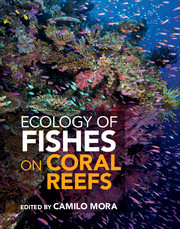Book contents
- Frontmatter
- Contents
- Preface
- Foreword
- List of contributors
- PART I BASIC ECOLOGY
- PART II PATTERNS AND PROCESSES
- PART III HUMAN FINGERPRINTS
- PART IV CONSERVATION
- PART V DEBATES AND PARADIGM SHIFTS
- 23 Is dispersal of larval reef fishes passive?
- 24 Density dependence and independence and the population dynamics of coral reef fishes
- 25 Equilibrial versus non-equilibrial dynamics in coral reef fishes
- 26 Cryptic density dependence: integrating supply-side ecology with population regulation
- 27 Priority effects
- 28 Inverted trophic pyramids
- 29 Shifting baselines in coral reef fishes
- 30 Pluralism explains diversity in the Coral Triangle
- 31 Reef fish biogeographical regions
- 32 Size and sex change
- 33 Quantifying reef fishes: bias in observational approaches
- 34 Seascape ecology of fishes on coral reefs
- 35 The future for coral reef fishes
- 36 Perpetual struggle for conservation in a crowded world and the needed paradigm shift for easing ultimate burdens
- References
- Index
32 - Size and sex change
from PART V - DEBATES AND PARADIGM SHIFTS
Published online by Cambridge University Press: 05 May 2015
- Frontmatter
- Contents
- Preface
- Foreword
- List of contributors
- PART I BASIC ECOLOGY
- PART II PATTERNS AND PROCESSES
- PART III HUMAN FINGERPRINTS
- PART IV CONSERVATION
- PART V DEBATES AND PARADIGM SHIFTS
- 23 Is dispersal of larval reef fishes passive?
- 24 Density dependence and independence and the population dynamics of coral reef fishes
- 25 Equilibrial versus non-equilibrial dynamics in coral reef fishes
- 26 Cryptic density dependence: integrating supply-side ecology with population regulation
- 27 Priority effects
- 28 Inverted trophic pyramids
- 29 Shifting baselines in coral reef fishes
- 30 Pluralism explains diversity in the Coral Triangle
- 31 Reef fish biogeographical regions
- 32 Size and sex change
- 33 Quantifying reef fishes: bias in observational approaches
- 34 Seascape ecology of fishes on coral reefs
- 35 The future for coral reef fishes
- 36 Perpetual struggle for conservation in a crowded world and the needed paradigm shift for easing ultimate burdens
- References
- Index
Summary
Many coral reef fish species change sex, and these fishes have been the focus of many studies on the evolution of sequential hermaphroditism. The adaptive significance of sex change is embodied in the size-advantage hypothesis (SAH), which suggests that individuals should change sex when the other sex has a higher reproductive value. Differences between the sexes in how reproductive value changes with body size are often the result of the mating system. The SAH has been used with considerable success to explain sex allocation in fishes, with striking matches between mating system and sexual pattern. The SAH is best applied at a higher level, specifying the circumstances where we would expect a species to show the sex-changing habit. It is less successful at specifying the actual size or age at which to change sex because that change is often socially controlled, with individuals taking advantage of specific mating opportunities as one sex or the other. Recent investigations into the selective dynamics involved in sex change have revealed some fascinating sexual patterns, including bidirectional and prematurational sex change, and circumstances where individuals choose not to change sex when provided with the opportunity. In each case, a dynamic approach that incorporates local social circumstances was instrumental in explaining these details of the sex-change habit.
Many coral reef fish species change sex [765], and these fishes have been the focus of many studies on the evolution of sequential hermaphroditism. The idea is simple: if individuals are flexible in terms of which sex they are at any particular time, they can profit by functioning as the sex that conveys the higher reproductive success, given the circumstances in which they find themselves. In other words, if the expected number of offspring produced (measured, say, as the number of eggs produced or fertilized) differs between the sexes in size or age, an individual that can function as the correct sex for the situation will have more offspring than one that remains exclusively male or female (see Figure 32.1).
- Type
- Chapter
- Information
- Ecology of Fishes on Coral Reefs , pp. 267 - 269Publisher: Cambridge University PressPrint publication year: 2015



